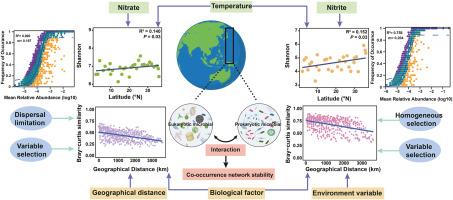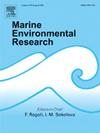厘清生物因素和非生物因素在塑造大空间尺度海洋微生物生物地理格局中的作用。
IF 3
3区 环境科学与生态学
Q2 ENVIRONMENTAL SCIENCES
引用次数: 0
摘要
对于大洋空间尺度上的微生物群落组成机制,人们仍然知之甚少,尤其是在生物因素的影响方面。本研究在西太平洋表层水域收集了 3772.55 公里横断面上的样本,并采用 16S 和 18S 核糖体 RNA 基因测序来阐明微生物群落的组装过程和驱动因素。在整个调查过程中,真核微生物群落(EM)和原核微生物群落(PM)都表现出显著的距离-衰减关系,尽管它们的组装机制不同。生物因素在形成真核微生物群落和原核微生物群落的生物地理格局中发挥了关键作用,这表明跨域微生物的相互作用对彼此的分布有着重要影响。此外,与关键类群相比,跨域微生物关系对共生网络稳定性的影响更大。这些发现加深了我们对大洋空间尺度上维持微生物多样性的机制和生物地理模式的理解。本文章由计算机程序翻译,如有差异,请以英文原文为准。

Disentangling the role of biotic and abiotic factors in shaping microbial biogeographic patterns in the large spatial scale ocean
Across large oceanic spatial scales, the mechanisms governing microbial community composition remain poorly understood, particularly regarding the influence of biotic factors. In this study, samples were collected over a 3772.55-km transect in the Western Pacific surface waters, with 16S and 18S ribosomal RNA gene sequencing employed to elucidate the assembly processes and drivers of microbial communities. Both eukaryotic (EM) and prokaryotic microbial (PM) communities exhibited a significant distance-decay relationship throughout the survey, although their assembly mechanisms differed. Biotic factors played a pivotal role in shaping the biogeographical patterns of both EM and PM communities, indicating that cross-domain microbial interactions significantly affect each other's distribution. Furthermore, the stability of the co-occurrence network was more strongly influenced by cross-domain microbial relationships than by keystone taxa. These findings advance our understanding of the mechanisms and biogeographical patterns sustaining microbial diversity across large oceanic spatial scales.
求助全文
通过发布文献求助,成功后即可免费获取论文全文。
去求助
来源期刊

Marine environmental research
环境科学-毒理学
CiteScore
5.90
自引率
3.00%
发文量
217
审稿时长
46 days
期刊介绍:
Marine Environmental Research publishes original research papers on chemical, physical, and biological interactions in the oceans and coastal waters. The journal serves as a forum for new information on biology, chemistry, and toxicology and syntheses that advance understanding of marine environmental processes.
Submission of multidisciplinary studies is encouraged. Studies that utilize experimental approaches to clarify the roles of anthropogenic and natural causes of changes in marine ecosystems are especially welcome, as are those studies that represent new developments of a theoretical or conceptual aspect of marine science. All papers published in this journal are reviewed by qualified peers prior to acceptance and publication. Examples of topics considered to be appropriate for the journal include, but are not limited to, the following:
– The extent, persistence, and consequences of change and the recovery from such change in natural marine systems
– The biochemical, physiological, and ecological consequences of contaminants to marine organisms and ecosystems
– The biogeochemistry of naturally occurring and anthropogenic substances
– Models that describe and predict the above processes
– Monitoring studies, to the extent that their results provide new information on functional processes
– Methodological papers describing improved quantitative techniques for the marine sciences.
 求助内容:
求助内容: 应助结果提醒方式:
应助结果提醒方式:


